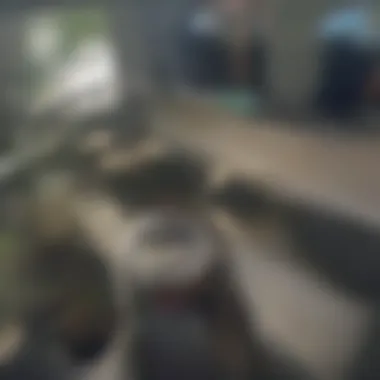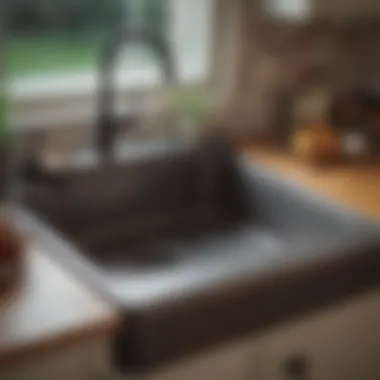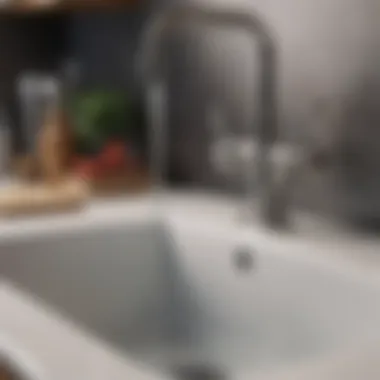Resolving Kitchen Sink Clogs Beyond the P-Trap


Intro
Clogged kitchen sinks can be a source of frustration for many homeowners. While the P-trap often receives significant attention when it comes to locating blockages, there are numerous issues that can arise further along the plumbing system. This article will explore various causes of kitchen sink clogs that occur beyond the P-trap, along with effective solutions. By understanding the common culprits and implementing diagnostic techniques, you can take charge of plumbing issues before they escalate. This guide aims to make complex subjects accessible for homeowners and maintenance professionals alike, providing practical insights into maintaining a smooth-functioning kitchen.
Understanding the Kitchen Sink Components
The Plumbing Layout
Understanding the plumbing layout of your kitchen is essential for troubleshooting clogs that extend beyond the P-trap. The sink's drainage system typically consists of several key elements: the drain line, vent stack, and connection to the main sewer line. Blockages can happen in any of these areas due to factors like grease buildup, foreign objects, or even tree root intrusion from outside.
Signs of a Clog
Homeowners should be aware of certain signs indicating a clog may exist beyond the P-trap. Common signs include:
- Slow draining sinks
- Gurgling noises when using the sink or nearby plumbing fixtures
- Backflow of water from the drain
Recognizing these symptoms early can prevent further complications.
Diagnosing Kitchen Sink Clogs
Effective diagnosis requires a systematic approach. Here are steps to identify potential causes:
- Visual Inspection: Look under the sink to ensure the P-trap is not the problem. Check for visible leaks or damage.
- Water Flow Test: Use water to test the flow rate. Observe if water backs up at the sink or elsewhere in the system.
- Snake the Drain: Employing a plumber’s snake can help you locate blockages deeper in the drain line.
These diagnostic steps are vital in determining the next course of action.
Preventive Measures
Maintaining your kitchen sink can help avoid future clogs beyond the P-trap. Here are effective strategies:
- Regular Cleaning: Ensure drains are cleaned periodically with a mixture of hot water and vinegar to dissolve grease and debris.
- Use Drain Screens: Installing strainers can prevent food particles and foreign objects from entering the drain.
- Mind What Goes Down the Sink: Avoid disposing of fats, oils, and grease in the kitchen sink as they contribute to buildup within the plumbing.
Taking these preventive measures can save you time and money in the long run.
Solutions for Addressing Clogged Drains
When you encounter a clog beyond the P-trap, consider these methods:
- Plumber's Snake: Use this tool to break up and extract clogs at various points in the drainage system.
- Hydro Jetting: This service uses high-pressure water jets to clean out pipes thoroughly. It is effective for tough blockages.
- Professional Service: If DIY methods fail, contacting a licensed plumber may be necessary to address complex plumbing issues.
Synthesizing the Information
Understanding Kitchen Sink Plumbing
Understanding kitchen sink plumbing is essential for tackling clogs that occur beyond the P-trap. It provides a foundational knowledge that helps homeowners diagnose issues effectively and avoid unnecessary plumbing emergencies. Knowledge of plumbing systems promotes informed decisions concerning maintenance and repairs. Without it, one might overlook critical elements that contribute to clogs, resulting in frustrations and increased expenses.
The Role of the P-Trap
The P-trap is a key component in kitchen plumbing. Its primary function is to trap debris, preventing it from passing further down the drainage system. Additionally, it holds a small amount of water to create a seal that stops sewer gases from entering the home. Understanding its role helps in recognizing that while it may seem like the primary barrier to clogs, other factors upstream can also contribute significantly to drainage issues.
Components of the Kitchen Drain System
The kitchen drain system consists of several components that work collectively to facilitate proper drainage. These include:
- Sink basin: Where water and waste initially collect.
- P-trap: As mentioned, it traps debris and prevents gases from entering.
- Drainage pipes: These connect the sink to the home's plumbing, directing waste away.
- Vent pipes: Ensure that air flows into the system, maintaining proper pressure and facilitating drainage.
Understanding each part aids in pinpointing where clogs might occur. Due to the complexity of the system, ignorance of how it functions could lead to ineffective responses to clogs. Familiarity with these components enhances maintenance efforts. If one can anticipate potential issues, they can take preventive measures before clogs develop.
Identifying Clogs Beyond the P-Trap
Identifying clogs beyond the P-trap is key for efficient kitchen sink plumbing. Understanding where and how these clogs form can help homeowners maintain their plumbing systems effectively. When a sink is slow to drain, it is essential to conduct a thorough investigation. Ignoring the issue may lead to more severe plumbing problems, increased costs, and further inconveniences.


Symptoms of a Clogged Sink
A clogged sink can manifest through a variety of symptoms. Recognizing these signs early can make the difference in addressing the problem.
- Slow Drainage: One of the first indications is slow drainage. If water pools in the sink, it suggests an obstruction within the drainage system. This could stem from food waste or grease.
- Unpleasant Odors: Foul smells emanating from the sink could mean stagnant water is trapped in the pipes due to a clog. This often results from decomposing organic matter.
- Gurgling Sounds: Unusual noises like gurgling can indicate that air is trapped within the plumbing. This air can escape through other openings, suggesting a blockage that requires attention.
- Backup of Water: Water backing up into the sink or causing issues in other fixtures can be a clear sign that the clog is extensive. This might also lead to water damage in cabinets beneath the sink.
Understanding the Drainage Path
To address clogs beyond the P-trap, one must have a solid grasp of the drainage path. The water flows from the sink through various components before exiting via the main line. Each of these pathways can be susceptible to blockages.
- Sink Basin: It begins in the basin where water collects. From here, it travels through the sink drain.
- Waste Arm: This is a horizontal pipe that connects to the vertical drainage stack. Blockages here can impede drainage.
- Main Wasteline: This line carries waste away from the home. Issues in this line often require professional help since it may involve more complex systems.
Understanding this path allows homeowners to assess potential problem areas more accurately. Regular inspections can prevent clogs from forming and save time along with money in the long run.
The accurate identification of clogs can prevent unnecessary plumbing complications and financial burdens. It is prudent to routinely check and maintain the plumbing system.
Common Causes of Kitchen Sink Clogs
Understanding the common causes of kitchen sink clogs is crucial for effective plumbing maintenance. Clogs beyond the P-trap can lead to significant issues if not addressed promptly. These blockages often stem from habits we may not consider harmful. By identifying the underlying causes, homeowners can take proactive measures to prevent future problems.
Food Waste Accumulation
Food waste is one of the primary culprits behind kitchen sink clogs. Many people utilize their sinks as a convenient disposal method for scraps and remnants. Over time, this practice can result in the buildup of food particles in the plumbing system.
- Types of food waste that contribute to clogs:
- Vegetable peels
- Coffee grounds
- Rice and pasta
These items do not break down easily and can accumulate in the pipes, progressively narrowing the drainage pathway. It is advisable to dispose of food scraps properly, ideally using a compost bin. This approach not only prevents clogs but also promotes environmentally friendly practices.
Grease Buildup
Grease is another major factor that causes kitchen sink blockages. When cooking, grease from meats, oils, and sauces can go down the drain. As grease cools, it solidifies and sticks to the inner walls of the pipes.
The moderation of grease disposal during cooking can effectively mitigate this issue. Here are a few strategies to consider:
- Allow grease to cool, and then dispose of it in a container.
- Use a paper towel to wipe down plates and pots before rinsing.
By changing these habits, grease buildup can be significantly reduced, resulting in fewer plumbing issues.
Foreign Objects in the Drain
Sometimes, clogs occur due to foreign objects entering the sink’s drainage system. Items such as utensils, bottle caps, or even toys can accidentally get washed down the sink.
These objects can lodge themselves in the pipes, creating a blockage.
To prevent such occurrences:
- Be aware of what goes into the sink.
- Consider using drain covers to catch small items.
Eliminating foreign objects from the drain can drastically reduce the risk of serious clogs.
Root Intrusions
In some cases, clogs are caused by natural elements, such as tree roots, which can intrude into underground pipes. The roots seek moisture and may grow through small cracks or joints in the plumbing system. As they grow, they can obstruct water flow, leading to severe blockages.
While this issue often necessitates professional assessment and intervention, homeowners should:
- Regularly inspect the vicinity of pipe installations for tree roots.
- Consider removing or relocating trees that pose a risk to plumbing.
Understanding these causes can equip homeowners with the knowledge needed to maintain their kitchens effectively. Taking preventive steps can conserve both time and money, potentially avoiding costly plumbing repairs.
Diagnosing the Location of a Clog


Diagnosing the location of a clog is a critical step in addressing kitchen sink issues, especially ones that occur beyond the P-trap. Understanding where the blockage lies can save time, money, and effort in resolving these plumbing problems. Approaching this process with methodical techniques not only aids in effective resolution but also minimizes the risk of causing additional damage to the plumbing system. Awareness of the signs and locations of potential clogs prepares homeowners and maintenance professionals alike to handle these issues efficiently.
Visual Inspections
A visual inspection is often the first line of defense when diagnosing a clog. It involves a careful examination of visible plumbing parts for any signs of blockage. Observations can be made around the sink area, underneath the sink, and along the exposed pipes. Look out for:
- Water pooling near the sink or floor.
- Unusual odors emanating from the sink or the drain area.
- Discolored water in the sink when drainage appears compromised.
In some instances, checking the kitchen sink drain basket can reveal trapped debris, like food particles or hair. Removing these items can often provide immediate relief. However, this method can sometimes miss deeper blockages. It may not reveal issues lurking behind walls or under floors where the plumbing system is hidden. Therefore, visual inspections should be part of a broader diagnostic approach.
Utilizing a Drain Camera
When visual inspections do not yield definitive results, employing a drain camera can be an invaluable technique. This method involves the insertion of a small, waterproof camera into the drain line. The camera transmits real-time video footage, allowing for precise visualization of the interior of pipes. Benefits of using a drain camera include:
- Detailed insight into the condition of pipes, helping identify clogs that visual inspections cannot locate.
- Diagnosis of pipe damage such as cracks or corrosion, which may contribute to recurring clog issues.
- Reduced guesswork, making it easier to formulate an effective action plan for unclogging.
Using a drain camera requires some technical know-how, but many plumbing services offer this as a part of their service package. For homeowners, investing in this technology can ultimately lead to more informed decisions and effective solutions.
"Diagnosing where the clog exists is vital. It directs you to the right actions for treatment and helps prevent unnecessary costs."
Effective Methods for Clearing Clogs
Addressing kitchen sink clogs effectively involves utilizing various methods tailored to the specifics of the blockage. Understanding and applying these methods can save homeowners both time and money in the long run. Each technique has its own benefits, considerations, and the situations in which they work best. Effective clog resolution can restore normal flow in the drainage system, ultimately leading to better overall plumbing health and reduced risk of future problems.
Using a Plumber's Snake
A plumber's snake, or drain auger, is a valuable tool for homeowners facing stubborn clogs. This flexible, spiral tool can navigate through bends in pipes, reaching blockages often missed by more straightforward methods.
- Benefits: The plumber's snake can handle various clog types, from solid food waste to hair and soap scum. It's more effective in deeper pipes where other methods fail.
- Considerations: Use caution when inserting the snake into the drain. Too much force can damage the piping. For best results, start with a gentle push to determine the nature of the blockage.
- Process: Begin by inserting the snake into the drain opening until it meets resistance. Slowly turn the handle to break apart the clog or hook it. Once cleared, run hot water to flush out loose debris.
Hydro Jetting Techniques
Hydro jetting is a high-pressure cleaning method that effectively clears more severe blockages. It utilizes powerful jets of water to scour the pipes clean, removing even long-standing obstructions.
- Benefits: This method ensures deep cleaning of the pipes. It can eliminate buildup from grease, sludge, and other materials that cause slow drains.
- Considerations: Hydro jetting is not suitable for all plumbing systems. Older pipes may be too fragile for such intense pressure. Consult with a plumbing professional to assess the state of your plumbing before attempting.
- Process: A professional plumber will use specialized equipment to insert a hose into the drain. Once properly positioned, high-pressure water blasts through the pipes, clearing any and all clogs while cleaning the pipe walls.
Chemical Solutions: What to Know
Chemical drain cleaners are a common choice for combating clogs. They can be effective but must be used judiciously, as some formulations may harm your plumbing system.
- Benefits: They are generally easy to use and often yield quick results. Most homeowners can apply them without needing professional help.
- Considerations: Not all products are safe for all types of plumbing. Some chemicals can corrode pipes, especially older ones. Always read the product label carefully and consider eco-friendly alternatives when possible.
- Process: Pour the chemical solution according to package instructions into the clogged sink. Allow it to sit for the recommended time before running hot water. If no improvement is observed, avoid repeated applications to prevent potential damage.
Important Note: Chemical solutions should not be used in conjunction with a snake or hydro jetting, as mixing chemicals can lead to dangerous reactions. Always follow safety guidelines when handling these substances.
Preventive Strategies for Kitchen Sink Maintenance
Preventive strategies are essential in maintaining the functionality of kitchen sinks. A thorough understanding of these practices can save homeowners time, money, and distress. By proactively addressing issues, you reduce the likelihood of clogs and other related plumbing problems. Prevention not only enhances the efficiency of your kitchen sink but also contributes to the overall plumbing health of your home.
Proper Waste Disposal Practices
Proper waste disposal is critical in keeping kitchen sinks clear. Homeowners should be vigilant about what they place down the drain. Here are several key practices to consider:
- Avoid pouring grease down the sink. Grease solidifies as it cools, leading to significant buildup.
- Limit food waste sent down the drain. Even with a garbage disposal, fibrous vegetables can cause problems. Instead, compost them if possible.
- Be cautious with food scraps. Small particles might seem harmless but can accumulate over time. Dispose of them in the trash or compost bin.
- Use drain strainers to catch larger debris before it enters your plumbing. This simple action can greatly reduce the chances of clogs.
By adopting these disposal practices, homeowners can significantly minimize the risk of clogs and maintain the longevity of their plumbing.
Regular Cleaning Routines
In addition to proper waste disposal, implementing regular cleaning routines is vital for effective maintenance. Cleaning the sink and drain not only improves sanitation but also allows for the early detection of potential issues. Below are effective strategies for routine cleaning:
- Weekly cleaning of the sink with mild soap and water. This keeps surfaces free from bacteria and unpleasant odors.
- Monthly inspections of the drain for any buildup. A simple visual examination can often catch problems before they escalate.
- Use baking soda and vinegar monthly to naturally deodorize and clear minor buildups. Simply pour baking soda followed by vinegar, let it sit for a while, and then flush with hot water.
- Keep the sink area dry after use. Moist environments promote mold and mildew, leading to more significant issues.


By maintaining a consistent cleaning schedule, homeowners can ensure their kitchen sinks remain in good working condition, thus avoiding future inconveniences.
When to Call a Professional Plumber
Deciding when to call a professional plumber is crucial in managing a clogged kitchen sink. Not all plumbing issues are suitable for DIY attempts. Lack of knowledge or experience can lead to further damage or extended downtime. Understanding the signs of a serious problem and recognizing your limits helps in ensuring both safety and efficiency.
Signs Indicating Professional Intervention
Some indicators clearly show when a plumber's expertise is required. When you notice repeated clogs, it might not be just a buildup that can be cleared with a simple method. More serious problems could be at play. Here are some signs to look for:
- Persistent Backups: If clogs reoccur despite your efforts, it’s time to consult a professional.
- Foul Odors: Unpleasant smells often suggest deeper issues within the plumbing system.
- Gurgling Sounds: If you hear unusual sounds from the sink or pipes, that could indicate a block in the vent system.
- Leaking Water: Any signs of leaks around piping need immediate attention to prevent further damage.
- Slow Draining: Ongoing slow drainage might signal a blockage farther down the line, beyond the P-Trap.
In all these situations, attempting repairs without the right knowledge may complicate the issue. It is wise to act sooner rather than later.
Finding the Right Plumbing Service
Choosing a reliable plumbing service can significantly influence the outcome of your plumbing issues. Not all plumbers have the same credentials or skill sets.
Consider these factors when selecting a professional:
- Experience: Look for plumbers with years of experience, especially in handling kitchen sink issues.
- Reviews and Recommendations: Check online reviews or ask friends for recommendations. These provide insights into the quality of service.
- Licensing and Insurance: Ensure that any plumber you hire is licensed and insured. This protects you from potential liabilities.
- Estimates: Request estimates before committing. This allows you to compare pricing and services.
- Warranty: Inquire if the plumber offers warranties on their work. This gives added assurance of quality.
Ultimately, investing in the right plumbing service can save time and prevent further complications with your kitchen sink. Efficient professionals can resolve issues effectively, ensuring long-term functionality.
The Financial Aspect of Clog Resolution
When faced with a clogged kitchen sink, the financial implications of resolution become a key consideration. This aspect of plumbing maintenance is often overlooked but can significantly impact overall budget. Homeowners and property managers must weigh various options, assessing the cost-effectiveness of different approaches. Understanding the financial aspects helps in making informed decisions regarding whether to tackle the problem independently or seek professional assistance.
Cost Considerations for DIY vs. Professional Help
Choosing between do-it-yourself methods and hiring a plumber can greatly influence both immediate expenses and long-term financial health. Here are some points to consider:
- DIY Methods:
- Professional Help:
- Costs are typically lower since you only need basic tools and some cleaning supplies.
- There are numerous online tutorials available that guide you through the unclogging process, making it more accessible for beginners.
- However, if the clog is beyond your skill level, you might end up causing additional damage, leading to higher repair costs.
- Hiring a plumber incurs an upfront cost, but you gain the expertise and experience needed to resolve complex issues.
- Professionals can quickly diagnose the underlying issues, ensuring a long-term fix, which may prevent recurrent clogs.
- Costs vary based on location and service provider, so researching and comparing options is prudent.
It's crucial to evaluate your own skills against the potential costs of errors to determine the best course of action.
Long-term Savings through Prevention
Investing in preventive measures can lead to significant financial benefits over time. By preventing clogs before they develop, homeowners can avoid expensive repairs and service calls. Some effective strategies include:
- Regular Maintenance:
- Quality Products:
- Schedule regular inspections and cleanings of plumbing systems to identify issues early.
- Simple actions like using strainers can prevent food waste from entering the drain.
- Using high-quality plumbing fixtures and fittings can reduce the likelihood of clogs.
- Invest in biodegradable disposables and avoid pouring grease down the sink, as it solidifies and causes blockages.
Approaching plumbing maintenance proactively leads to a less stressful situation and keeps your budget intact.
"An ounce of prevention is worth a pound of cure."
Ending
Summarizing Key Points
To summarize the key points discussed:
- Understanding Kitchen Sink Plumbing: Knowledge of P-trap and the drainage system is essential. A clogged sink often indicates issues deeper in the plumbing.
- Identifying Clogs Beyond the P-Trap: Symptoms such as slow drainage or unusual odors signify potential blockages. Recognizing the drainage path helps pinpoint problem areas.
- Common Causes of Kitchen Sink Clogs: Accumulation of food waste, grease build-up, foreign objects, and root intrusions are leading causes.
- Diagnosing the Location of a Clog: Employing visual inspections and drain cameras aids in finding difficult clogs.
- Effective Methods for Clearing Clogs: Solutions include using a plumber's snake, hydro jetting, or chemical solutions carefully.
- Preventive Strategies for Kitchen Sink Maintenance: Adopting proper waste disposal habits and regular cleaning can greatly reduce clogging incidents.
- When to Call a Professional Plumber: Identifying the signs that require professional help can save time and stress.
- The Financial Aspect of Clog Resolution: Weighing DIY solutions against professional help and understanding long-term savings through preventive measures.
Encouraging Routine Maintenance
Routine maintenance is fundamental for sustaining your kitchen sink's performance. Regular cleaning can significantly reduce the risk of future clogs. Homeowners are encouraged to develop a few simple habits:
- Proper Waste Disposal: Always dispose of food waste in a compost bin or trash, rather than down the sink.
- Regular Cleaning: Frequently clean the sink and surrounding areas. Use natural cleaners like baking soda and vinegar to eliminate residues without damaging pipes.
- Monitor Drain Usage: Be attentive to how the sink drains after washing dishes. If drainage slows, address it immediately rather than waiting.
- Annual Inspections: Consider scheduling an annual plumbing inspection to catch potential problems early.
Incorporating these practices makes it easier to keep kitchen plumbing in excellent condition. Understanding and addressing the complexities of kitchen sink plumbing can lead to a more efficient home and averted inconvenience.



